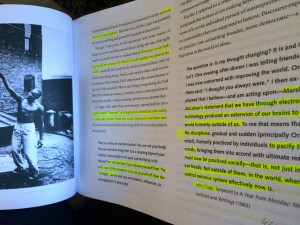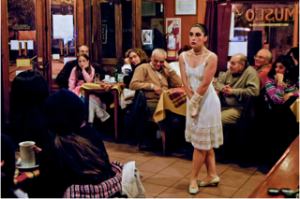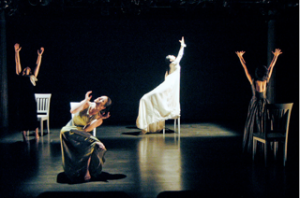by Katie C. Sopoci Drake
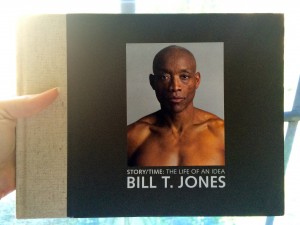 STORY/TIME is a three-part book that also serves as a companion piece to the Bill T. Jones/Arnie Zane Dance Company’s live production of Story/Time that will appear at New York Live Arts on November 4-8, 11-15 at 7:30pm. More information: http:www.newyorklivearts.org
STORY/TIME is a three-part book that also serves as a companion piece to the Bill T. Jones/Arnie Zane Dance Company’s live production of Story/Time that will appear at New York Live Arts on November 4-8, 11-15 at 7:30pm. More information: http:www.newyorklivearts.org
After the lengthy acknowledgements to many honored academics, distinguished artists, and an impressive list of foundations and trusts, the first thing to strike the reader soundly across the brain is a preface that warns you that what you are about to experience is really a structured event, “a performance yearning to be a document, a book” that serves as a “record of a needy, angry, and confused man” with a need “for a tradition, an intellectual home”. After a description of the book’s layout, a hint at how you might best take in the information (an “invitation to play” or “reorder if you will”), and properly braced with what contradictions may present themselves, you delve into the first of three sections of the book.
This first section, titled “Past Time” plunges you into Jones’ experience within the 1970‘s dance scene. You witness him meeting with the ideas of John Cage, the growing importance of his ideas on Jones’ own artistic inquiries, and are confronted with random stories and images that evoke place and history. Jones’ feelings of exclusion from the intellectual community of scholars and artists of the time surfaces within the narrative providing fire behind Jones’ evidently voracious appetite for inquiry and the contradiction within himself between “comfort” and “provocation” within his own methods of creating live performance that “reveal the most personal aspects” of himself.
The second section, “Story/Time”, “a response to John Cage’s 1958 Indeterminacy,” is laid out like a score with dashes and brackets marking the time and random order (with the help of www.random.org) of 60 one-minute stories. These nuggets of prose, with words that are nudged and pulled apart on the paper to mark the passage of time, span the range of Jones’ own history and memories. Some having to do with art, some with family, some with characters from his life, certain stories swim back to the surface after their initial appearance in the first section of the book “Past Time”. Here they are washed clean of their previous context, and elevated to the status of art.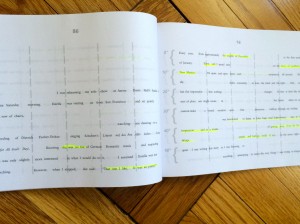
“Story/Time” begs to be read out loud. At the end of the previous section, “Past Time”, Jones gives us hints at his approach in performance which certainly invites the reader to try one or all stories in their own tongue. 17 unsentimental performance images accompany this leg of the journey giving the viewer a setting for the stories and reminds us of Jones’ questioning of his own interpretation of Cage’s theories assigning “a higher priority to the author’s intent or choices of presentation than to the audience’s capacity to interpret that intent.”
In “With Time”, the final section of the book, you read Jones’ thoughts on the direction of dance as an art-form with the benefit of having read about both his own journey towards this end and experiencing a sample of what his deep artistic inquiry has rendered. In it, he offers yet another twist in his journey in the form of praise he received from his niece in 1999 after a performance of We Set Out Early… Visibility Was Poor. Jones reveals that at that moment, she had represented another “community I had — justifiably or not — felt estranged from.” This revelation brackets a series of “provocations” that keep circling back around within the book: detachment from emotion in art, exclusion from intellectual society, estrangement from community, the class context of searching for identity versus the search for meaning, the role of history and personal experience in experimental art.
In a final interview with Laura Kuhn, Executive Director of the John Cage Trust, John Cage, Jones’ “icon of modernism”, is partially laid bare. Kuhn relates a story of Cage being so detached from society that he didn’t realize Jesse Jackson was black. The story doesn’t seek to embarrass the man, but to reveal a consequence of a philosophy that separates the artist from society. Directly after the interview, Jones identifies his desire to reconcile the community he grew up in with the artistic community he is immersed in and the contradiction of “choosing to engage seriously with such a socially ‘unengaged’ artist who seems to hard back to an era when the only artists who mattered where male and white. And yet engage with John Cage I must.”
As a written document, this book is clearly organized, quickly read, and dense with musings that can be dissected by dancers and non-dancers alike. As a piece of art, it is both process and product in one. The engagement and participation of audience member might be enhanced if the book is read and discussed in a group setting which makes me curious to see how it will fit with the live performance and how many people will pair the two. The experiment in creation, design and performance certainly poses many questions that, identifying as a dance artist, I found myself musing in the context of own work. Likewise, as an academic, I found I was concurrently dissecting the book for use in a future class. I found the “provocation” of personal context and its link to the audience’s experience of art particularly poignant when my thoughts swung back around to a quotation of Michel Auder which was, perhaps, not so randomly selected to end “Story/Time”: “’You motherfucker! You were thinking about yourself while watching my work!’”.
STORY/TIME: The Life of an Idea
By Bill T. Jones
Performing Arts, Dance, Memoir
108 pp. Princeton University Press. $24.95
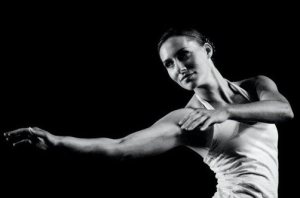
Photo by Scott Pakudaitis
Contributor Katie C. Sopoci Drake, MFA, GL-CMA, is a Washington D.C. based professional dancer, choreographer and teacher specializing in Laban-based contemporary dance. Holding an MFA in Dance from the University of Wisconsin-Milwaukee, a Graduate Certification in Laban Movement Analysis from Columbia College – Chicago, and a BA in Theatre/Dance with a minor in Vocal Performance from Luther College, Sopoci Drake continues to take classes in as many techniques and practices as she can handle to inform her work and life as a curious mover.
Katie has been on faculty at The University of Wisconsin-Milwaukee, Nova Southeastern University, Miami Dade College-Wolfson, Miami Dade College-Kendall, Carthage College, and Lawrence University. She currently guest teaches and gives masterclasses around the D.C. area and wherever her travels take her.
As a performer, Sopoci is described as a “sinuous, animal presence of great power; watching her dance is a visceral experience.” (Third Coast Digest). Company credits include Mordine and Company Dance Theater of Chicago, Momentum Dance Company of Miami, Wild Space Dance Company of Milwaukee, and Rosy Simas Danse of Minneapolis. Katie has also made appearances an an independent artist with many companies including Brazz Dance, Your Mother Dances, The Florentine Opera, and The Minnesota Opera.
Katie’s choreography, described as “a beautiful marriage between choreography, music and poetry” (On Milwaukee), arises from her fascination with the idiosyncrasies of daily life, and the flights of fancy that arise from ordinary inspirations. Her work has been performed by numerous companies, colleges and studios across the country and her latest collaboration, Telephone Dance Project, will take her to states up and down the East Coast while investigating long-distance creation and connecting far-flung dance communities.





